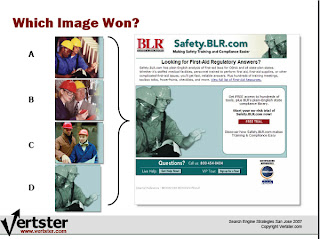Day 2
4:45 – 6pm
Landing Page Testing & Tuning – was a great class about ways to get a better return on your website, and how to better tune your conversions through testing.
4 Speakers:
Tim Ash, Site Tuners
Tom Leung, Google
Scott Miller, Vertster
Jamie Roche, Offermatica
So……Why should people care about tuning your conversions? Because neglecting your landing pages can be very costly. The formula for CPA = CPC/CR. I hate formulas and its the end of the day so I’m not defining it further. Really, it comes down to the question “Who should design your website?” Your Ad Agency? Your boss? Your webmaster? The answer is actually none of the above…it should be your CLIENTS. I’m liking this so far, because I always try to put myself in the client’s shoes and advise accordingly. Not my clients, their clients. 🙂
What should you tune on your website?
– landing pages leading to trackable actions
– price of your product or service
– headlines, page layout, buttons, graphics, CTA (you know that means calls to action by now, right?), colors, nav, and copy. Phew. Anything else guys? The part that sucks about testing… is I’ll do all the above and throw out 3 of 4 samples I worked hard on. But as a webmaster, I have to put on my big girl panties and deal with it, because it drives conversion.
Of course there’s more. Now you’ve decided what to tune, its time to decide which method you prefer to tune with. There are 3 main methods of testing:
1. A-B split testing, which is where you test one variable at a time. This is usually done using anywhere from 1-10 new pages or “recipies” for pages
2. Multivariable testing, which is where you have multiple changed variables and you have designed various “experiment” pages.
3. Proprietary testing, which is personalizing pages toward certain targets
When you test, you must FIRST establish a baseline. If you don’t do this, all your data will be skewed, and you’ll get thrown off by spikes and trends. You need to measure everything relative to your baseline, and devote bandwidth to the current version of your site for your already converting users.
Its also important to collect enough data, but not too much. There’s so many numbers to consider, its best to have someone who knows what they are doing collect stats and report back. Don’t get caught without enough data. Another “don’t” is ignoring your variable interactions.
The next speaker was Tom from Google, he reminded the PPC people in the room that they pay for all of their visitors, but over half immediately leave 🙂 How can you stop people from abandoning you??? He mentioned there are a few good tips and tricks at http://services.google.com/websiteoptimizer/
Tom encouraged a few thoughts to consider before running your test: decide what pages, how long, and what to test next (aka have a strategy not a slew of numbers flying at you).
He mentioned 4 javascripts to include in your code while testing:
1. Control script
2. Section script
3. Tracking script
4. Conversion script
How to test them? Pick a page, tag it, type in content, and launch variations for testing. If you don’t add variations you won’t know which sections have the most influence. Tom also mentioned tried-and-true tests you can trust:
- Multivariate
- A/B
- Split Path
- Multi-page multivariate
- Time based
Try to really optimize the experience, not just the page 🙂
Next up Scott Miller gave us a roadmap to success. He suggested:
Test your offer. This means the value prop, headlines, supporting copy, scarcity generation, price, promos, risk reversal, live chat, sitepal, and anything you can think of after that.
Test takeaways. Read a sales book if you don’t get that, I liked The Sales Bible.
Test getting the user’s attention. Aka logos, headlines, taglines, imaging, audio/video…images are usually the most important. Focus above the fold, on eyetracking studies, and “blink of an eye” mentality. Have you got their attention?
 It wasn’t my personal favorite, but the answer was D. It just goes to show, that’s why you test.
It wasn’t my personal favorite, but the answer was D. It just goes to show, that’s why you test.
Last up for the day (phew my head is spinning can we go to Google dance yet?) is Jamie Roche to talk a bit about personalization of testing. He has found that it works, and that Amazon is a great example with their “if you bought ____”, “you may also want _____”, feature. It also works to pull the keyword friends come through with and put it on the landing page strategically.
Jamie suggested we group our audience in buckets. BIG buckets, not little micromanaged buckets. Why does everyone at SES talk about buckets??? I am going to call them duckets cuz its like dollars and buckets 🙂 So your duckets should be: Behavior, Time-based, Source, Environment, Registered customer, Time of day, Geographic region. There’s lots of duckets to be made!
Make sure to pick a thoughtful starting point, like your committed visitors. Begin with something obvious and work from there. Then choose your approach – revolutionary VS evolutionary. Sometimes you have to have a revolution and do really big things. Don’t be scared, be educated and be bold 🙂
Now that you know all kinds of tests and testing strategies, are you ready to run them on your website? bleah, not me. The truth hurts, and testing is not something I enjoy. Conversions are good though, so a-testing we will go…



